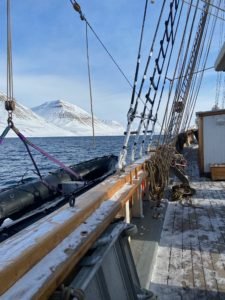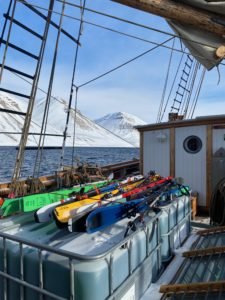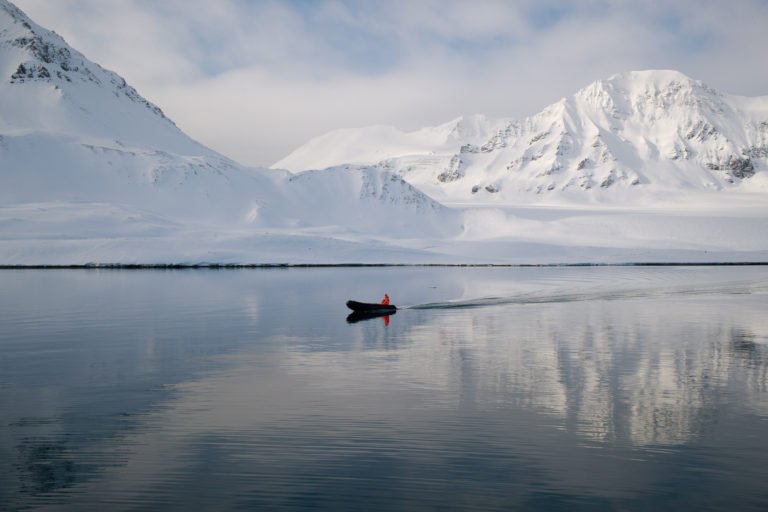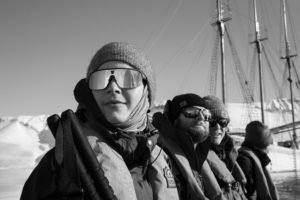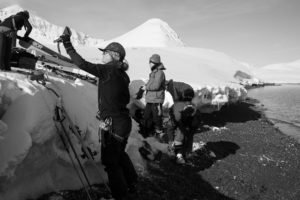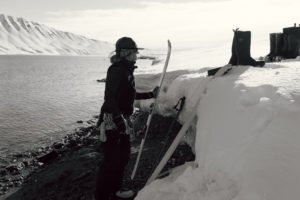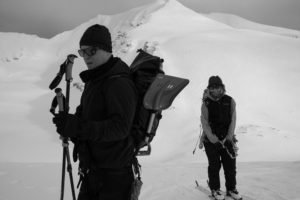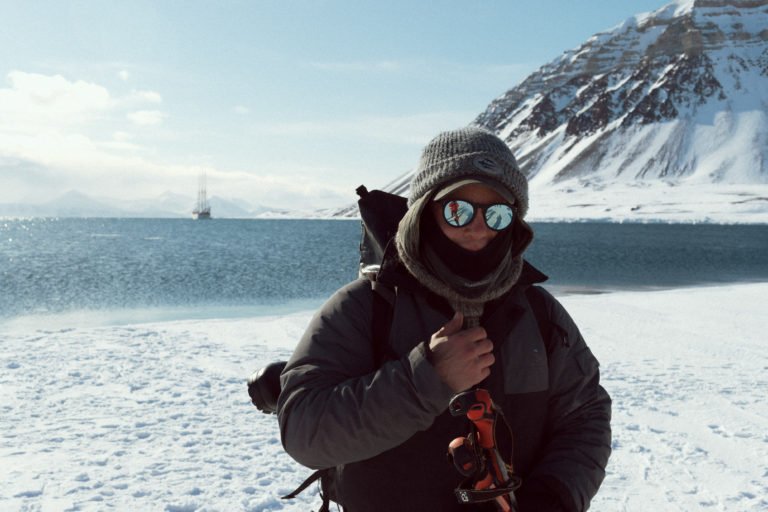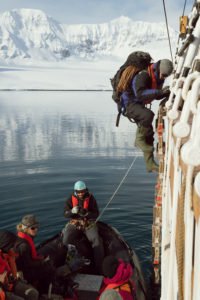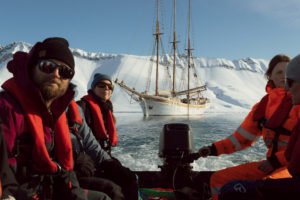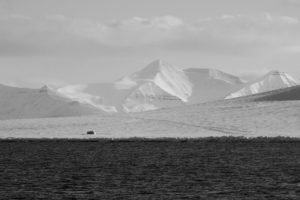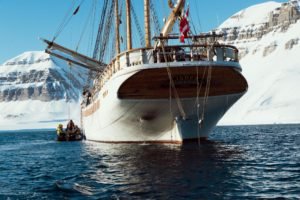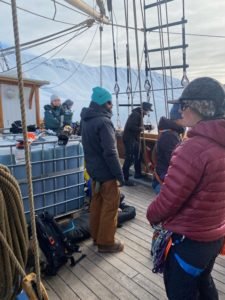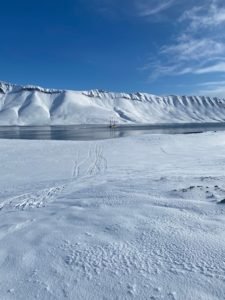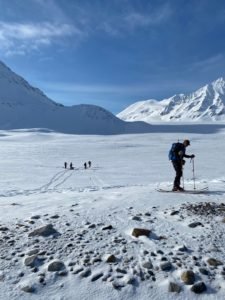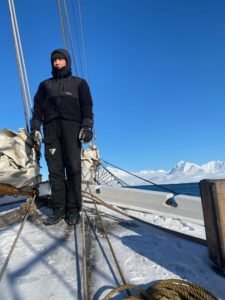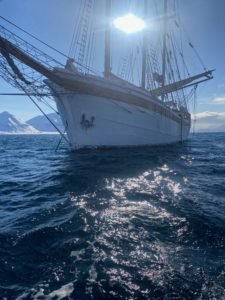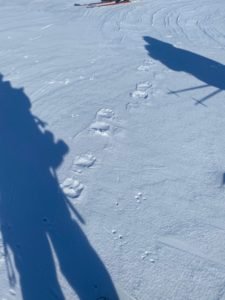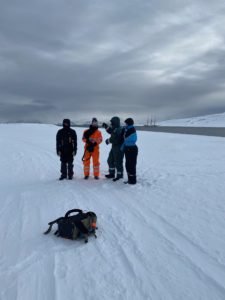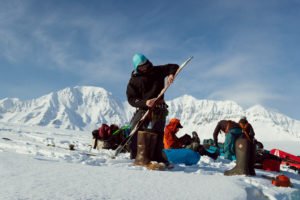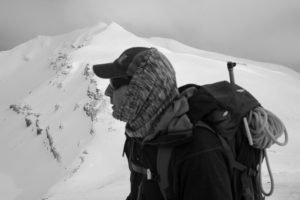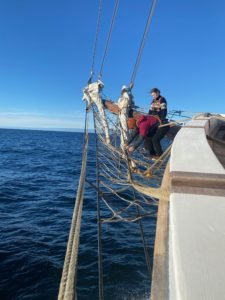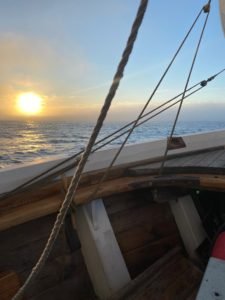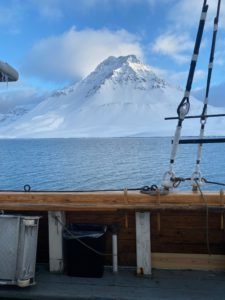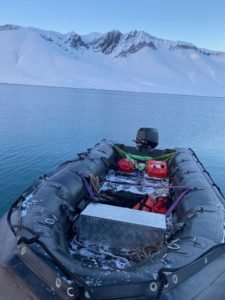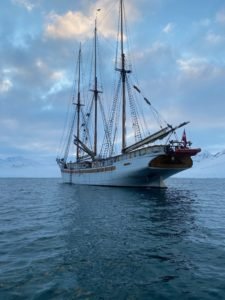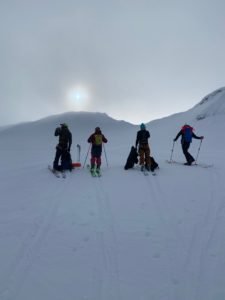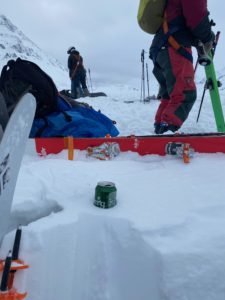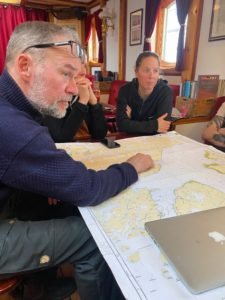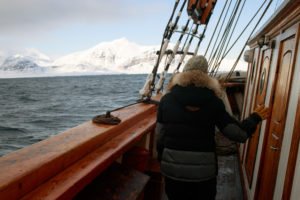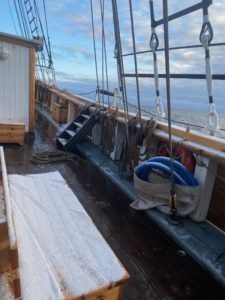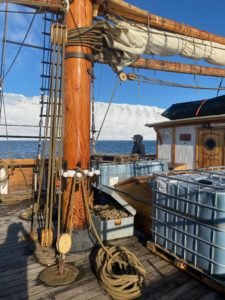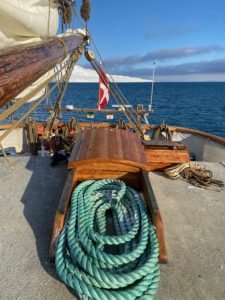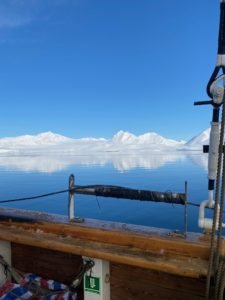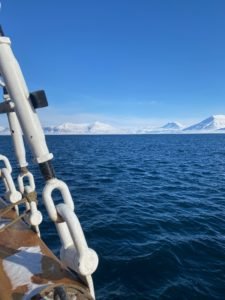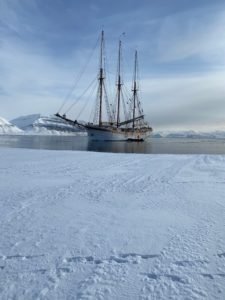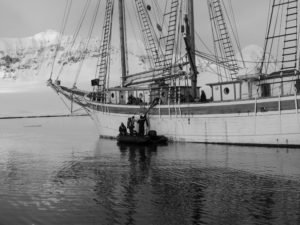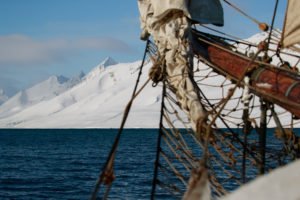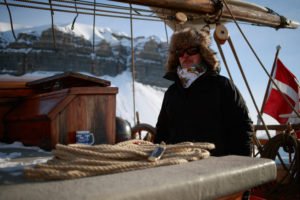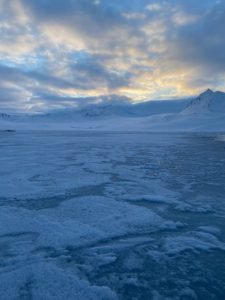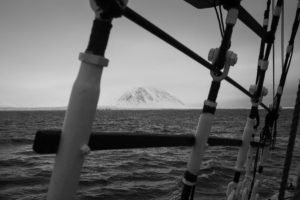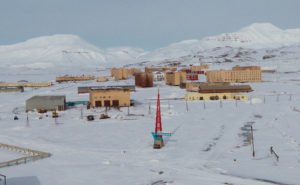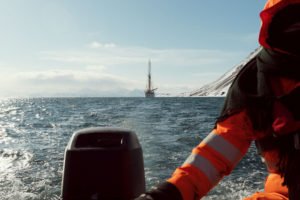Svalbard expedition III: Skiing the Arctic, Searching for Pyramiden
Morning. A silver mug of black coffee on the deck of a schooner.
Perhaps it harkens back to the Adak, or even earlier, tendering on the Heron for sea cucumbers with Grant Miller, prowling the inside waters in November picking up product when this ritual started.Later on tending Spencer on the Snorkel as he dove for sea cucumber, fishing in Security Inlet for pinks with Karl on the Saturday. Pouring hot water over the grounds, taking the cup out on deck, squinting into the cold and sipping as the wind gusts over the water, waves lapping at the planking as the day broke.
It’s one of my earliest memories of being in Alaska, that feeling of newness and possibility, being both in the moment and outside it, life compressed into a single morning. What better way to greet the cold blue than with a scalding cup of coffee?That inky black Joe like a squirt of ether for a chilled 4-stroke, kickstarting your heart, preparing it for a series of coherent decisions over the course of the next fifteen hours.To recognize as wind cuts through flannel still warm with the night’s sleep that the unwanted is wanted, that the coming day will not be easy, and yet there are pleasures to be had. That no matter the trials you will have clear eyes and a strong, supercharged heart.
So it was on the morning of April 23rd. We woke on the western coast of Spitsbergen, in a small bay off Isfjorden, about halfway between mainland Norway and the North Pole. We had bluebird skies and an otherworldly surrounding of mountains. After that harrowing, puke-filled journey across the Barents Sea, we had made it. Siggy scanned the sea ice and flats beneath the turquoise glacier rim for lurking polar bears, then pronounced us clear.
“You think we’ll be seeing polar bear on this trip?” I asked.
“Yes.”
I had been told the Arctic was fragile. I had been told the Danish were a drunken, gregarious bunch. Neither seemed true. The land around us did not appear fragile, and Siggy much more like me in attitude than I would have predicted him to be. At the back of the bay mountains pushed up from the flats of a snow-covered glacier like peaks of beaten egg whites. I could see pocks along the sea ice where seals had broken through to catch a breath. Already the ice had skimmed over. I had read that Svalbard was experiencing climate change at three times the rate of the global average. Glaciers calved and permafrost melted. Yet that first morning the archipelago struck me as a land new and clear and unobstructed and majestic. A landscape I didn’t recognize, that I couldn’t even relate to what I knew – not the mountains in Colorado or the glaciers in Alaska.
In short, it felt like a different planet.
Overnight a column of ice had developed between the sea and the outboard on the Zodiac. As the sun rose above the unnamed peak to our east we milled about the deck gathering our avalanche beacons, shovels and ski crampons and skins. I zipped on my robin blue 686. Threads of cold air worked through cracks. Everyone else had Arc’teryx and Mammut. Here I was with my 686, making the sign of the horns with my fingers. “Let’s shred the nar nar!”
We climbed down the ladder to the boat, and skiffed up to the lip of the ice, those without waterproof boots getting piggy-back rides to the edge. We put on skins, clipped in, got up on skis and tied off to the ropes for skiing across the glacier. Siggy remained below, in radio contact with us to warn of any polar bear. He wore on his back a 6.5 Creedmore, which seemed severely underpowered for a polar bear, but I knew he was good with it.
With Dustin leading our line we ascended, the Swiss with their split-boards, the rest of us with backcountry skis. At the top of the glacier the Americans veered right in the direction of a pass while the Swiss (led by Kot, from Denmark) climbed a mountain to the east. As we climbed we realized that we had taken both the flare guns and .308 rifle, which Justin wore. The Swiss were unarmed.
Needless to say this unleashed a waterfall of insensitive Americans joking about how tasty Swiss chocolate and Danishes are for polar bear. Followed by silence, until someone said that the Swiss could be genuinely angry about the Americans taking all the guns. Which led to the scenario of the Swiss maybe actually encountering a very real polar bear, and how bad we would feel as a group if the Swiss, along with Danish Kot, were actually eaten.
To feel better, we skied. John, Ben, Dustin and I broke off and made it up to the pass. The sun turned into a flame-white disc in silken mist – I couldn’t get Danse Russe from my head. Edges fell off the land. At the top of the pass John wanted to go higher along the spine of the ridge but Ben hopped off without a care in the world. Then it was me; as gravity pushed, the light became so flat it was difficult to get all the systems to agree – balance, sight, sound, feel – whether the body was in motion or not. It felt like vertigo. All you could see and hear was granules of snow moving beneath and around your skis. Completely disorienting. At one point I just sat down. A complete white-out.
After struggling through our existential crisis at physically confronting the blah of life in the form of a white-out, we we found the rest of our crew, and skied to the curve in the glacier to join up with Kot and the thankfully intact Swiss. It was unclear whether they had noticed that they were unarmed. Once more Jordan insisted we all must watch Wes Anderson’s Life Aquatic so we could figure out our analogs – he had strong feelings about this. We discussed it and decided we felt safe skiing the glacier without roping up. We all (as far as I could discern) wanted to watch movies and eat chocolate, Swiss or otherwise, and drink mulled wine. The snow was not awesome and the cold gnawed at the lobes of our ears.
As we skied down I could see Siggy’s form below glassing for polar bear. Sofie came in on the Zodiac, bringing Carlsberg and Isfjorden beers, cookies, and chips in a white trash bag. As we peeled skins off our skis we drank Carlsbergs stuck in the snow and spoke of the thrill of “earning your turns” in the Norwegian Arctic. Was it the best snow ever? No. Were we drinking Isfjorden and Carlsberg beers stuck in the snow of the Arctic to cool down, preparing to hop on a Zodiac to board a Danish three-masted schooner? That had a sauna? Yes.
After four days of throwing up on/into tough seas, skiing seemed, how can I say it, superfluous. Life was a precious bird we all held in cupped hands. I wanted to get into that sauna, and climb down the ladder into the icy water to remember the heat. Drink mulled wine in the evening while recalling the white-out. Wake and go out on the cold deck with a hot cup of coffee and, as the day before, greet the unknown day, knowing I had a good heart, whole skis, and a savage team on that sailboat at my back, ready to invade an abandoned Russian coal mine.*
On the bright morning of April 25th the temperature dropped yet again. We were dealing with -15 Fahrenheit with winds gusting to -25. It had been colder in Siberia, but this was a damp cold. Stand too long out by the helm and your head started to hurt, the tips of your fingers began to ache, and your heart – despite the warm coffee you continued to dose it with – began to slow.
Still we all reported on deck in our long johns and Anoraks and snowboard jackets to lift the sails as Rasmus directed us east into the toward Pyramiden. The canvas glowed a brilliant cream color with neat shadow lines of rigging cutting across it as we cut the engine and moved at a steady six knots through the water. We passed the bay containing Longyearbyen, the northernmost substantial settlement on earth, and got a brief flurry of messages. Suddenly we were all on our phones, silent, tapping away at the small boxes. It was weird. Then the signal disappeared, and we returned to working the sails and preparing our gear for the journey into Pyramiden.
It had become clear in the quiet, byzantine way truths develop on a boat that the Soviet-era coal mine ghost town was our snow leopard, our blue bear, our jaguar shark, in the words of Steve Zissou. This is where we needed to go.
As we took turns at the helm and unleashed the flying jibs on the bowsprit (with ropes and harnesses) we began to consider logistics. We (read Rasmus) weren’t sure how far the ice extended out from the fjord where the coal mine was located.Over maps and weather reports Rasmus devised a plan to check the ice, then retreat to a bay just to the south where an abandoned boat and trapper’s cabin lived along the coast. The site of a failed marble mine. There we’d anchor and make our plans.
As we sailed we’d filter in and out of the salon, engaging in a conversation over what might actually happen at Pyramiden. Rasmus predicted there might be just a guard there – he said that few people would be traveling by snow machine – called “scooters” in Svalbard – to the spot from Longyearbyen, especially following the recent boycott of Russian communities in Svalbard. A friend from Alaska had put me in touch with a man from the Netherlands who lived in Longyearbyen – and he said NOT to stop in Barentsburg, because people in Longyearbyen would find out, and perhaps not let you anchor or get gas up. But he made no mention of Pyramiden.
A conversation ensued.
“There are many polar bears here,” Siggy warned. “A polar bear got into the kitchen in Pyramiden. They are known for hiding in the empty buildings.”
I couldn’t get Winston Churchill out of my head. “We shall fight them on the beaches, we shall fight them to the end, we shall fight them in the fields” – or however that went. Except now it would be about polar bears and Russians. It all seemed very surreal.
As I passed through on the way to the helm I offered up for consideration my experience that Russians insisted on registering you whenever you traveled. If it was just a guard there he would want to see identification. Would they even want Americans prowling around, passports or not? We wouldn’t be on Russian land, technically. Or would we? The Russian Company Trust Arktikugol owned it. Like the Russian-American Company, that established Alaska, it was unclear the extent to which Artikugol was private, or part of the Russian state. Perhaps we would be in Russia. After all, there was no private property in Svalbard – at least people couldn’t own land. Yes, there was the treaty of Svalbard, but the Russians didn’t recognize it. NATO had no sway up here. Would the rooms even be heated? It was only getting colder, with gusts across the sea ice at a good -30.
Then Megan perked up. “Hey guys. I got a signal. I’ve been texting the woman at Pyramiden. She’s heating the rooms.”
It was all very confusing. Then it wasn’t. Thanks Megan.
The passport question remained, and we had lost contact with Megan’s informative Russian, a woman who secretly depressed me because she spoke very good English and I very much wanted to use my Russian in Pyramiden.Or what John better described as “getting your rocks off speaking Russian.” Rasmus said chill. If passports weren’t required to enter Svalbard, there was no reason to bring them to Pyramiden. We all trusted Rasmus. Passports were left behind. Once more we were calm, and slept.
As we entered the fjord with Pyramiden in back I noticed a marker along the edge in the exact shape of drawings of a lighthouse on Signal Island, just beyond the breakwater in Sitka. It is thought that Alcatraz is the earliest lighthouse on the west coast, 1845 or some such – but this is untrue.The Russians built one at the turn of the 18th century – there are drawings on Russian maps from 1807. Showing a lighthouse looking exactly like the marker leading into Pyramiden.
Rasmus glassed the sea ice. “Not bad,” he pronounced. He said it would be a good five miles in by ski to Pyramiden. Doable. We anchored up in the bay, with the trapper’s cabin and old boat. And then Siggy, with in his lugubrious monotone, announced that a polar bear and her cub were eating a seal on the south side of the bay.
Thus began a flurry of activity, which I wish I had photos of – but alas my phone froze.Not only in the metaphorical sense – it got to be such a cold brick as I was out there on the Zodiac pointing it at the white shapes of the polar bears that it just gave up. Jordan was shooting on film.He hadn’t recharged his camera once, just his fingers for advancing to the next frame. For the billionth time I cursed the stars for not being born a few centuries earlier, before cell towers, before electricity, before recalling that chances are I wouldn’t have made it past war-age, and I should consider myself lucky to be filling my lungs with this achingly cold air.
Instead of dead, somewhere around the midpoint of my trip around this earth, I’d be embarking the following day on a trip across the sea ice with two mountain guides, a special forces PJ, a photographer, two badass tech dudes and skiers, two Danish cooks, a Danish backcountry guide, and a 23-year-old son of a whale biologist, trained by Inuits to hunt polar bear.And the three Swiss, whose cards game with bulls and numbers I just could not get enough of.
To prepare for it all, I went into the sauna with the Swiss and dunked three times into the icy bay to stop my heart and give it a good reset for the day to come.
